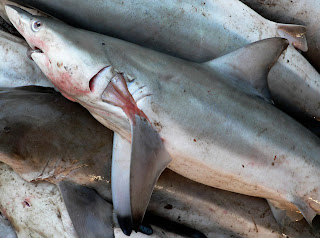
The record for a swordfish caught on rod and reel is 1,182 pounds, off Iquiguq, Chile, on May 7, 1953.Swordfish are large, highly migratory predators distributed throughout the world's marine ecosystem. They generally migrate between colder waters in the summer to warmer waters in the winter for spawning. In the Atlantic Ocean, swordfish range from Canada to Argentina in the west, and from Ireland to South Africa in the east. Swordfish are also found in the Indian and Pacific Oceans. Adult and juvenile swordfish feed at the highest levels of the food chain. This means they are not typically prey to other animals and are important in keeping the ecosystem in balance by consuming smaller fish and invertebrates.
Effective October 17th, 2007, a new internet based reporting system for recreational non-tournament landings of North Atlantic swordfish and billfish will be available. All recreational non-tournament swordfish and billfish landings, including those from Charter/Headboats, must be reported by the permitted owner of the vessel landing the fish, or their designee, within 24 hours of landing. A landed fish means a fish that is kept and has been brought to shore. Vessels landing swordfish or billfish in North Carolina and Maryland must report their landings through the state landing card programs. Vessels landing swordfish or billfish in all other states, including Puerto Rico and the U.S. Virgin Islands, must report their landings using the new internet reporting portal at http://www.hmspermits.gov or by calling the 1-800-894-5528 reporting line.
The recreational daily swordfish retention limit is 1 fish per person, with a maximum of 4 fish per private vessel, 6 for a charter vessel, and 15 for a headboat vessel. The minimum size for swordfish within the recreational fishery is 47 inches, lower jaw-fork length. You may not keep longbill spearfish. There are no retention limits for Atlantic sailfish, blue marlin and white marlin, but the NOAA Fisheries encourages recreational anglers to release all billfish alive. The minimum sizes for billfish are as follows: Blue Marlin: 99 inches lower jaw fork length; White Marlin: 66 inches lower jaw fork length; Sailfish: 63 inches lower jaw fork length; Spearfish: Retention prohibited. Lower jaw fork length is a straight line measurement from the tip of the lower jaw to the fork of the caudal fin. The recreational limit on sharks is 1 shark per vessel per trip with a minimum size of 54 inches fork length; plus on Atlantic sharpnose shark per person per trip (no minimum size); plus 1 bonnethead shark per person per trip (no minimum size). None of these fish may be sold. Swordfish and billfish landed must be reported. For swordfish and billfish reporting, call 800-894-5528. credit info to
http://www.nmfs.noaa.gov/




















